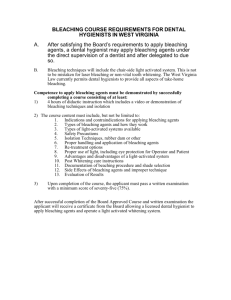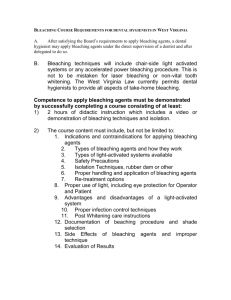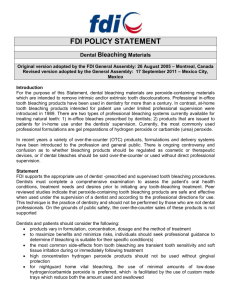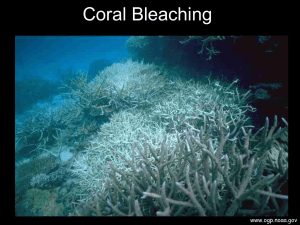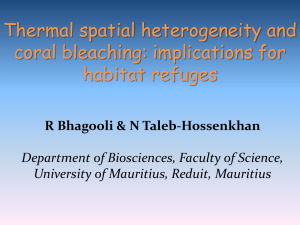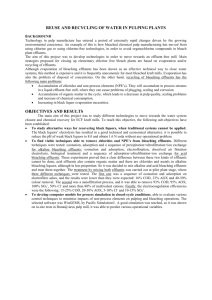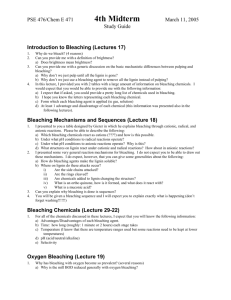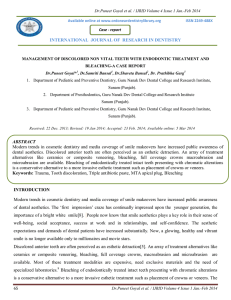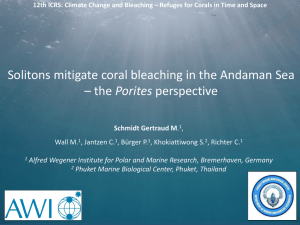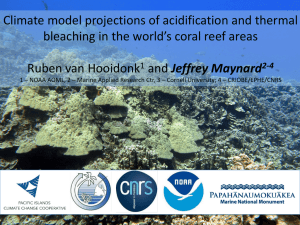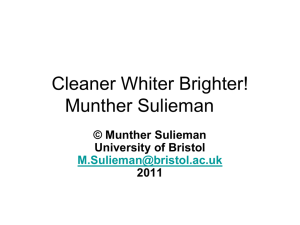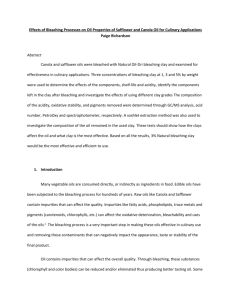Details of the sudden onset bleaching model
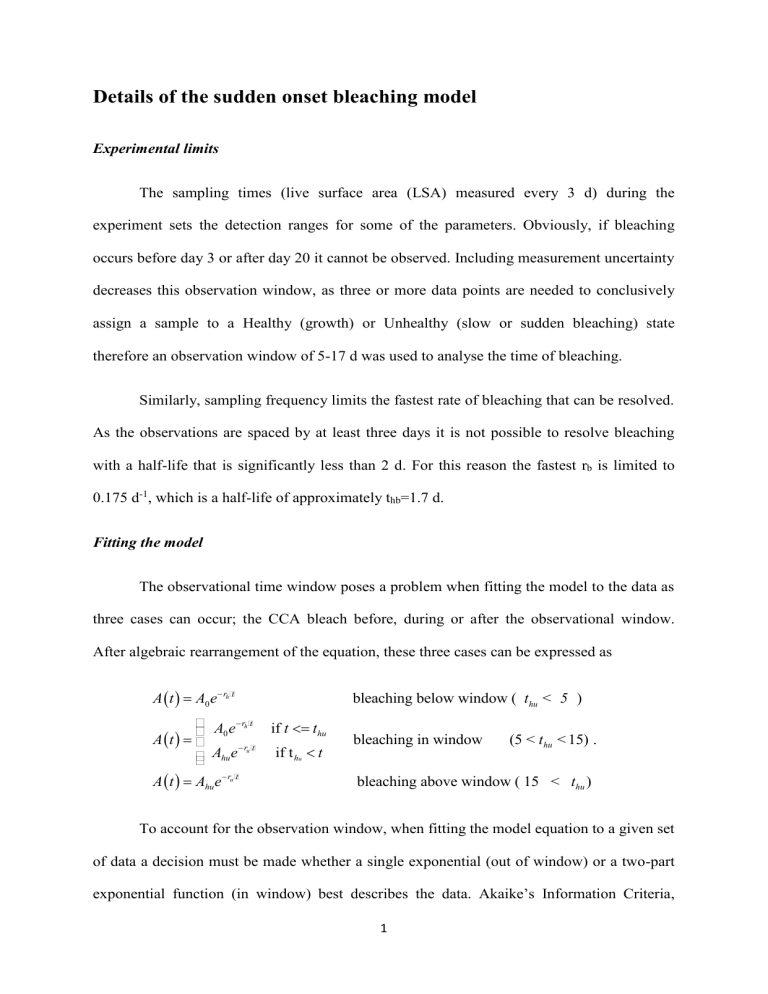
Details of the sudden onset bleaching model
Experimental limits
The sampling times (live surface area (LSA) measured every 3 d) during the experiment sets the detection ranges for some of the parameters. Obviously, if bleaching occurs before day 3 or after day 20 it cannot be observed. Including measurement uncertainty decreases this observation window, as three or more data points are needed to conclusively assign a sample to a Healthy (growth) or Unhealthy (slow or sudden bleaching) state therefore an observation window of 5-17 d was used to analyse the time of bleaching.
Similarly, sampling frequency limits the fastest rate of bleaching that can be resolved.
As the observations are spaced by at least three days it is not possible to resolve bleaching with a half-life that is significantly less than 2 d. For this reason the fastest r b
is limited to
0.175 d
-1
, which is a half-life of approximately t hb
=1.7 d.
Fitting the model
The observational time window poses a problem when fitting the model to the data as three cases can occur; the CCA bleach before, during or after the observational window.
After algebraic rearrangement of the equation, these three cases can be expressed as
( ) =
A
0 e
r h bleaching below window ( t hu
< 5 )
( ) = ×
A t
××
( ) =
A
A
0 e
r h
A hu e
r u hu e
r u
× if t
<= t hu if t h u
< t
bleaching in window (5 < t hu
< 15)
bleaching above window ( 15 < t hu
)
.
To account for the observation window, when fitting the model equation to a given set of data a decision must be made whether a single exponential (out of window) or a two-part exponential function (in window) best describes the data. Akaike’s Information Criteria,
1
which allows models of different complexity to be compared by taking into the account the goodness of fit and the number of parameters, was used to choose the most appropriate model
for each data set (Burnham and Anderson 2002). As the number of observations is low
Akaike’s Information Criteria with small sample size correction (AICc) has been used:
The best model is the one with lowest AICc as it represents the best trade-off between fit and complexity. The two-part model was chosen as its AICc score was significantly
smaller; following guidelines (Burnham and Anderson 2002) a threshold of 3.5 was used.
Statistical analysis of parameters
For each population and treatment the rate and transition time parameters were fit to a distribution. As the amount of data collected was limited, only distributions that were biological plausible and had a minimum number of parameters were selected.
• Healthy CCA, whose growth rates were small negative or small positive numbers, corresponding to an increase or a slow decrease in size, respectively, were fit to a normal distribution (Fig. S2).
• Unhealthy CCA could exhibit very large bleaching rates due to a rapid decrease in size of
LSA (and never an increase). For these reasons the bleached rates were described with a lognormal distribution (Fig. S2). However, given the smaller number of data points and the heavy censoring (see below explanation) any strictly positive, heavy tailed distribution could describe the data equally well. The log-normal distribution is consistent with bleaching rates
2
• The time of bleaching was modeled by the Weibull distribution as bleaching can be viewed as either a Mean Time Between Failure or with survivorship problem.
Estimating the parameters of these distributions is challenging as the data is heavily censored; the observation is incomplete due to the 3 d gap between sampling times which puts an upper bound on the fastest bleaching rate that can be observed within the experimental window (3 - 20 d). This means that only bleaching times between ~5 d and ~17 d can be assessed.
The parameters were estimated by least squares fitting the empirical cumulative distribution function to the analytic cumulative distribution function in the gnuplot program
(Williams and Kelley 2010). Error ranges for the parameters were calculated by parametric
bootstrapping.
Partition threshold
The observed rates were assigned to either a Healthy or an Unhealthy state. For some of the data this was possible as the growth rate is positive (must be healthy by definition) or a bleaching event was observed. Unfortunately it is not possible to unambiguously observe rates of change in LSA as they could contribute to either healthy CCA that is quickly decreasing in LSA or to a slowly bleaching CCA. This type of ‘missing label’ problem can be addressed in the Maximum Likelihood framework by using Expectation Maximisation. A simpler approach is to define a threshold to partition observations in the two distributions.
The threshold used to partition the observed rates of change in LSA (r p
) was determined by finding the rate that best separates the normally distributed healthy growth
3
rates from the log-normally distributed bleaching rates. That is, using the estimated parameters for the two distributions the rate that corresponds to equal probability of being in the tail of the healthy growth rate distribution and being in the front of the bleaching rate distribution was found. Mathematically,
Find r p
such that:
1
-
CDF norm
( r p
, m
, s
)
=
CDF log-norm
( r p
, m
*
, s
*
)
This equation was solved using Newton’s method. The partition threshold (Fig. S3) is most important when the mean growth rates are positive, so to simplify the analysis a single value for the partition threshold, r p
=0.015 d
-1
, was used for all locations.
Factorial ANOVA followed by Tukey HSD test using STATISTICA version 10.0
(StatSoft, Tulsa, OK) was applied to calculate differences in the rate of change in LSA between Heron and Lizard Island CCA fragments at different temperatures (normal distributed rates < 0.015; Fig. 3). The percentage of live surface area following the thermal
stress was also investigated via a linear mixed effects model (LME) (Pinheiro and Bates
2000) incorporating the multiplicative fixed effects of temperature and location and an
identity variance structure to accommodate unequal variances (Fig. S6; Table S1).
4
References
Burnham KP, Anderson DR (2002) Model selection and multimodel inference: a practical information-theoretic approach.
Springer-Verlag, Ney York
Jokiel P, Coles S (1977) Effects of temperature on the mortality and growth of Hawaiian reef corals.
Mar Biol
43:201-208
Pinheiro JC, Bates DM (2000) Mixed-effects models in S and S-PLUS.
Springer-Verlag, New York
Williams T, Kelley C (2010) Gnuplot 4.4: an interactive plotting program.
Official gnuplot documentation, http://sourceforge net/projects/gnuplot
5
